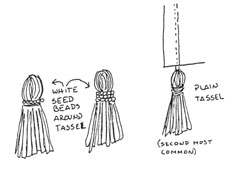
Pouch & Bandolier
| Backing, Edging & Detailing by David Mott and in 19th Century Seminole Men`s Clothing
|

Pouch & Bandolier
| Backing, Edging & Detailing by David Mott and in 19th Century Seminole Men`s Clothing
|
BACKING
After beadwork is completed, it is time to attach a calico liner
to back the wool. (Some choose to add two liners: one before beading,
to give the thread extra thickness to anchor in, and a second
after beading.) This reinforces the wool, and protects the beadwork's
bare backstitches. The liner should be just a bit larger than
the wool piece by about 1/8" to 1/4". On a few examples,
such as the "Osceola" pouch at the Florida Museum of
Natural History, the liner wraps around from the back and is sewn
down as an edging. This is an option to consider, but one which
will not be discussed here.


The calico liner can be attached with 1/2" basting stitches, because it will later be securely attached when edging is sewn on (unless the liner is, itself, the edging). When done, cut off any excess calico. Allow plenty of extra seam space if the calico was ripped; this helps prevent losing the stitch to the fray later on.
EDGING
There are two options to edging a bandolier and pouch. One is
by overlapping the calico liner around the outside edge of the
wool. The other option is to use ribbon or military edging or
bias tape for edging. This method, much more prevalent, is the
one described here.
Edging colors on examples studied are red, navy blue, black, green,
blue-green/turquoise, pink, yellow (changed with age to light
gold or mustard), white, and light blue. (See Appendix *1 COLORS)
Measure the dimensions of your pouch and bandolier outer margins.
If you would like the bottom of the pouch to have trim, sew it
down along that edge. (Very few pouches have this detail, but
it is an option.) Add edging to the open lip of the pouch, which
will protect the seam of the wool and calico. Sew the edging down
close to its edge, using small tight stitches, with a thread color
that matches the edging. This edging should have been slightly
longer than the edge it's going on so that it will be a simple
matter to trim off its ends after its sewn down.



Fold the pouch into the envelope shape. Sew the sides together
from bottom to top. Take care to run your stitches tight and with
as narrow seam as your torn calico allows. Measure the perimeter
of the pouch, including the flap, and add two inches. Measure
out this much edging, and sew it down in the same way as the lip
edging. Take your time around the flap's point to carefully fold
and stitch the edging to make it neat. Finish both of the open
bottom ends of the edging with a few tight barrel stitches. If
you are working with satin or silk ribbon for edging, use a very
fine needle and thread.

 The bandolier is edged in the same manner: 1) measure the perimeter
and add a few inches, 2) you may want to pin the ribbon in place
since the length can be overwhelming sometimes, 3) sew using very
fine stitches, and 4) take your time going around corners and
into the curves at the bases of the fingers. After all the edging
is done, the pouch and bandolier are ready for the finishing details.
The bandolier is edged in the same manner: 1) measure the perimeter
and add a few inches, 2) you may want to pin the ribbon in place
since the length can be overwhelming sometimes, 3) sew using very
fine stitches, and 4) take your time going around corners and
into the curves at the bases of the fingers. After all the edging
is done, the pouch and bandolier are ready for the finishing details.
DETAILING
Adding these details will enhance an already beautiful item.
EDGE BEADING: Add beads to the inside and/or outside
edge of the edging. These beads were almost always white, and
were often slightly larger than the beads used in the applique
designs.
TASSELS: These are hand-tied dangles added to the
bottom of the pouch and sometimes to the ends of the bandolier
fingers. They can be made from yarn, colored embroidery floss,
very thin wool strips, or unraveled wool/strouding. Between four
and eight on the bottom of the pouch is normal, but there can
be as many as a dozen. One per. finger end is the norm on the
bandolier. The tassels can be attached close in, or suspended
an inch or two.
How to Hand-Tie Tassels:
 | 1. Cut 10 to 20 4-6' lengths of yarn. |
 | 2. Run another 4-6' length of yarn around the bundle and tie off with a square knot. |
 | 3. Drape the yarn over the know leaving one end of the knot yarn above. The other end joins the bundle. |
 | 4. Using either the same color yarn (usual) or another color thread (sometimes) wrap around the top 1/3 of the bundle. Tie off with a couple clove hitches. Trim bottom as needed. |


 | To attach the tassel run a yarn or heavy thread through the head of the tassel. Add beads or leave plain. Pull through the bottom edge of the pouch and then make several overhand knots or a surgeons knot. Use a darning needle to thread the yarn. |
 | For the fingers of the strap or the flap point run the yarn just behind the edging, pull through about 1/2" and then knot. |
Seminole Bandolier Attachment & Conclusions
Appendix & References for Seminole Pouches & Bandoliers
Return to the Introduction to Seminole Pouches & Bandoliers
Complete Index to Articles in 19th Century Seminole Mens Clothing

|
Text and Graphics
© 1994 - Tara Prindle unless otherwise cited. |